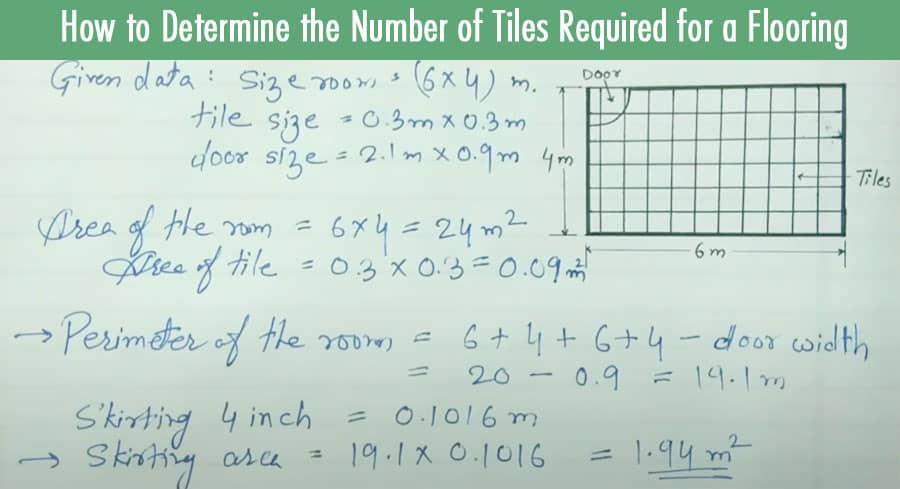How to Determine the Number of Tiles Required for a Flooring

When it comes to flooring, tiles are a popular choice due to their durability, versatility, and aesthetic appeal. Whether you are renovating your home or building a new one, knowing how to determine the number of tiles required for your flooring project is crucial to avoid under or overestimating the amount of materials needed.
Understanding the Basics of Tile Measurements
Before we delve into the process of calculating the number of tiles required, it is essential to understand the basic measurements used in tile installations. The two primary measurements used for tiles are:
- Size: Tiles come in various sizes, such as 12x12 inches, 16x16 inches, or 24x24 inches. The size of the tile will determine how many tiles are needed per square foot.
- Square Footage: This is the total area of the space to be tiled, usually measured in square feet.
Measuring the Flooring Area
To determine the number of tiles required, you first need to measure the flooring area accurately. Here's how to do it:
- Measure the length and width of the room in feet using a tape measure.
- Multiply the length and width to get the total square footage of the room.
- Repeat the process for each room you plan to tile.
- Add up the square footage of all the rooms to get the total square footage.
Accounting for Wastage
When calculating the number of tiles required, it is essential to account for wastage, which can occur due to cutting tiles to fit around corners, edges, or irregular shapes. A good rule of thumb is to add 10% to the total square footage to account for wastage.
Calculating the Number of Tiles Required
Now that you have the total square footage and accounted for wastage, you can calculate the number of tiles required for your flooring project. Here's how:
- Determine the size of the tile you plan to use.
- Divide the square footage of the room by the size of the tile to get the number of tiles required per room.
- Multiply the result by the number of rooms to get the total number of tiles required.
- Add 10% to the total number of tiles to account for wastage.
Choosing the Right Grout and Adhesive
When it comes to tile installations, choosing the right grout and adhesive is crucial to ensure a long-lasting and durable floor. Here are some factors to consider when selecting grout and adhesive:
- Type of Tile: The type of tile you choose will determine the type of adhesive and grout required. For instance, natural stone tiles may require a different adhesive and grout than ceramic tiles.
- Level of Traffic: The level of foot traffic the floor will endure will determine the type of grout and adhesive needed. For high traffic areas, a stronger adhesive and more durable grout may be necessary.
- Climate: The climate in your area will determine the type of grout and adhesive needed. For instance, in areas with high humidity, a water-resistant adhesive and grout may be necessary.
Conclusion
Calculating the number of tiles required for your flooring project may seem daunting at first, but with a little knowledge and preparation, it can be a straightforward process. Remember to measure the area accurately, account for wastage, and choose the right grout and adhesive for your specific needs. By following these steps, you can ensure a successful and long-lasting tile installation.
FAQs
How do I know how much wastage to account for when calculating the number of tiles required?
A good rule of thumb is to add 10% to the total square footage to account for wastage. This will ensure that you have enough tiles to cover any cutting, breakage, or irregular shapes.
Can I use the same adhesive and grout for all types of tiles?
No, the type of tile you choose will determine the type of adhesive and grout needed. For instance, natural stone tiles may require a different adhesive and grout than ceramic tiles. It is important to consult with your tile supplier or installer to ensure you are using the right materials.
How do I know if the grout and adhesive are suitable for the level of traffic in my space?
The level of foot traffic the floor will endure will determine the type of grout and adhesive needed. For high traffic areas, a stronger adhesive and more durable grout may be necessary. It is important to consult with your tile supplier or installer to ensure you are using the right materials for your specific needs.
Do I need to account for wastage if I am using large tiles?
Yes, wastage can occur even with large tiles, as you may need to cut them to fit around corners, edges, or irregular shapes. It is important to add 10% to the total square footage to account for any wastage.
Can I install tiles myself or do I need to hire a professional?
While it is possible to install tiles yourself, it is recommended to hire a professional for the best results. A professional installer will have the knowledge, skills, and tools needed to ensure a successful and long-lasting tile installation.
